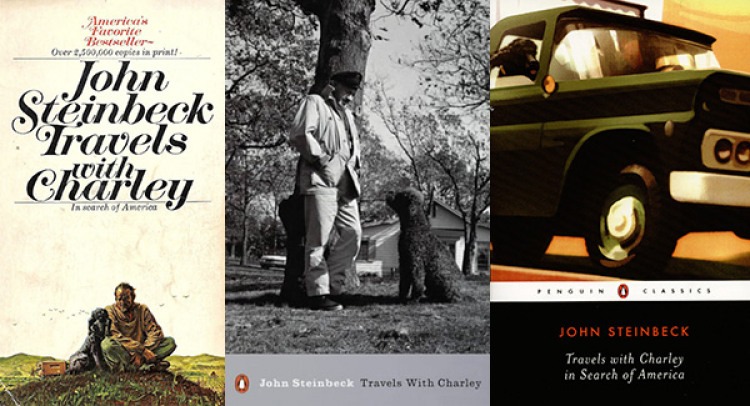An appreciation of John Steinbeck’s “Travels with Charley”
When he was twenty-five, working as a caretaker at a Lake Tahoe lodge during a snowy winter and trying to become a novelist, John Steinbeck confided in a letter to a young woman that he was quite worried because his only companion, an Airedale, had learned to swear. Where the dog had learned such a thing, Steinbeck couldn’t imagine. Nearly a decade later, traveling in Mexico, he wrote a letter to a friend about how wonderful Mexican dogs were. One dog he studied, whom he arbitrarily named Corazon del San Pedro Martin de Gonzales y Montalba, would lie on his owner’s doorstep and chase away all pigs but the owner’s pigs, guarding street trash against foreign pigs. One day when a “very big old pig” defeated the dog in a brief skirmish, Steinbeck said, “Corazon after one howl, walked sheepishly back to his doorway. He glanced over to see whether I had noticed, and when he saw that I had, he bit hell out of one of his own chickens.” A year after witnessing Corazon’s understandable bitterness in defeat, back in California, Steinbeck found that his new setter pup had eaten half of the manuscript he was working on, a draft of Of Mice and Men. “Two months work to do over again,” he said to his agents, adding, “I was pretty mad but the poor little fellow may have acting critically.” He didn’t discipline the pup, he explained, because he didn’t see the point of punishing “a good dog for a mss I’m not sure is good at all.”
There were always dogs in Steinbeck’s life—his dogs and other people’s dogs—but no dog ever matched the stature of Charley, the standard Poodle with whom Steinbeck traveled across America in 1960 in a journey that would produce his hugely popular Travels with Charley.
John Steinbeck IV, the author’s younger son, once told me that he thought his father had made up many of the conversations in Travels with Charley. His father, he said, was far too shy to have engaged so many strangers in talk. Going back to examine the many conversations the elder Steinbeck had as he meandered across America in a truck called Rocinante with a Poodle named Charley, it struck me that John IV may have been right. So many of the bits of dialogue in the book, the random conversations with random strangers met in odd moments, are just too pat and too convenient. They serve the author and book too well. But one exception stood out for me everywhere in this wonderful book. I don’t believe Steinbeck made up a single word of his many conversations with Charley.
Steinbeck’s only traveling companion was, as the author puts it, “an old French gentleman poodle …” Charles le Chien was, we’re told, the actual name for this dog born in Bercy just outside of Paris and trained in the French tongue. While Charley knew “a little poodle-English,” Steinbeck wrote, “he responds quickly only to commands in French. Otherwise he has to translate, and that slows him down.” Charley “is a good friend and traveling companion, and would rather travel about than anything he can imagine.”
In my brittle, seventy-five-cent 1963 paperback edition of Travels with Charley, Steinbeck mentions his Poodle on 103 out of 275 pages. Charley is everywhere in the author’s material world and in his mind, and Steinbeck uses Charley mercilessly to unpack his own thoughts, judge and evaluate his passing neighbors, and serve as a kind of objective correlative to the world he’s bucketing though in an overloaded, camper-shelled pickup. Charley is a pacifist dog with a roar like a lion. He is a “born diplomat” and a “mind-reading dog.” He is an aging gentleman with a bad prostate and bladder problems. His crooked front teeth allow him to pronounce “the consonant F” and cause him to say “Ftt” when he must politely and apologetically request a bathroom stop. “It is my experience,” Steinbeck writes, “that in some areas Charley is more intelligent than I am, but in others he is abysmally ignorant. He can’t read, can’t drive a car, and has no grasp of mathematics. But in his own field of endeavor, the slow, imperial smelling over and anointing of an area, he has no peer.”
One of the elements that make Steinbeck a great writer is his respect for life, all life, and in the scope of that respect Steinbeck gathered in everything from stones and tidepools to dogs and human beings and redwood trees. There’s no meanness in Steinbeck’s writing, and his respectful attention to the smallest details of existence is tinged always with a pleasant self-deprecating humor. The beauty of his relationship with Charley lies just there. Charley is treated with all the respect any human companion might have expected, and he is also treated with the same degree of mockery a human sidekick would have received. When he sees a rising trout in a pool at sunset, Steinbeck writes, “Charley saw it too and waded in and got wet, the fool. He never thinks about the future.” When Charley’s amorous attentions to a Pomeranian arouse the ire of both plump dog and plump and inebriated owner and gets Steinbeck bitten by one and chewed out by the other, he writes, “Charley regarded the whole scene as nonsense … After all I’ve done for him you’d think Charley would have come to my aid, but he dislikes neurotics and he detests drunks.” After a particularly fine hell fire and brimstone sermon in a New England church, Steinbeck says, “It gave me a lovely sense of evil-doing that clear through till Tuesday. I even considered beating Charley to give him some satisfaction too, because Charley is only a little less sinful than I am.” He goes on to write: “Even at his age he is a vain dog … when Charley is groomed and clipped and washed he is as pleased with himself as is a man with a good tailor or a woman newly patinaed by a beauty parlor … A wealth of combed and clipped mustache gave him the appearance and attitude of a French rake of the nineteenth century …”
Charley becomes for Steinbeck the intellectual and moral standard by which to judge his fellow Americans. “Confronted with our stupidities,” Stenbeck writes, “Charley accepts them for what they are—stupidities.” At one point, Steinbeck confesses in an irritated voice, “Charley had forgiven me in a nauseatingly superior way …”
Steinbeck has many conversations with Charley, including a deep pondering over gods and fate and faithful animals in which he complains to the Poodle, “I could tell you many stories about faithful animals who saved their masters, but I think you are just bored and I’m not going to flatter you.” Charley, says Steinbeck, “leveled at me his most cynical eye. I think he is neither a romantic nor a mystic.”
Perhaps the highlight of Steinbeck’s long journey through America with his Poodle—and the moment that best defines this wonderfully quirky author’s relationships with his canine friends—comes in the California redwoods. Steinbeck, who loved pranks and jokes played on comrades, plays an elaborate trick on Charley. He writes, “Now, there is not any question that Charley was rapidly becoming a tree expert of enormous background. He could probably get a job as a tree consultant with the Davies people. But from the first I had withheld from him any information about the giant redwoods. It seemed to me that a Long Island Poodle who had made his devoirs to Sequoia sempervirens or Sequoia gigantia might be set apart from other dogs, might even be like that Galahad who saw the Grail. The concept is staggering. After this experience he might be translated mystically to another plane of existence … The experience might drive him mad. I had thought of that. On the other hand, it might make of him a consumate bore.”
Most wonderful about all of this is that Steinbeck doesn’t just use Charley as an excuse to show off his verbal wit. Rather, he drives into the redwoods groves of northern California, finding the tallest, largest tree he can locate, and lets Charley out in what he calls “dog’s dream of heaven in the highest.” Watching with delighted anticipation, he is mortified when Charley ignores the monstrous tree: “If I thought he did it out of spite or to make a joke,’ I said to myself, ‘I’d kill him out of hand. I can’t live without knowing.” Steinbeck cuts a willow branch and sticks it into the trunk of the redwood and brings the branch to Charley’s attention. Charley dutifully pees on the twig and Steinbeck says no more about it in the book.
Near the end of the book, Steinbeck has a long conversation with Charley, Charley’s half of the dialogue consisting of interpreted tail waggings:
“What’s the matter, Charley, aren’t you well?”
His tail slowly waved his replies. “Oh, yes. Quite well, I guess.”
“Why didn’t you come when I whistled?”
“I didn’t hear you whistle.”
“What are you staring at?”
“I don’t know. Nothing I guess.”
After the wistful dialogue continues for a while, Steinbeck asks Charley when his birthday is, and Charley doesn’t know. Steinbeck decides to make a pancake-mix cake for Charley’s birthday anyway, and Charley responds with “delicate conversation” made by tail wags: “Anybody saw you make a birthday cake for a dog that he don’t even know when’s his birthday would think you were nuts.” Steinbeck replies, “If you can’t manage any better grammar than that with your tail, maybe it’s a good thing you can’t talk.” Charley licks the pancake syrup and looks up at Steinbeck to say, “What makes you so moony,” and when Steinbeck explains, Charley says, “Let’s take a stroll up the hill …”
Steinbeck simply loved the world around him, rejoiced in its oddities and quirky creases, and respected every nook and cranny of life. Looming large in that world were dogs. He loved dogs, always had dogs as companions, and granted dogs the same respect he gave to his fellow humans, which means he let them in on his jokes, made them the butts of his jokes, confessed to them, philosophized with them, and allowed them the same intellectual and emotional complexity he found in everyone else.

 Various covers of “Travels with Charley”
Various covers of “Travels with Charley” John Steinbeck’s typewriter (note the inscription “THE BEAST WITHIN”)
John Steinbeck’s typewriter (note the inscription “THE BEAST WITHIN”)
No comments:
Post a Comment